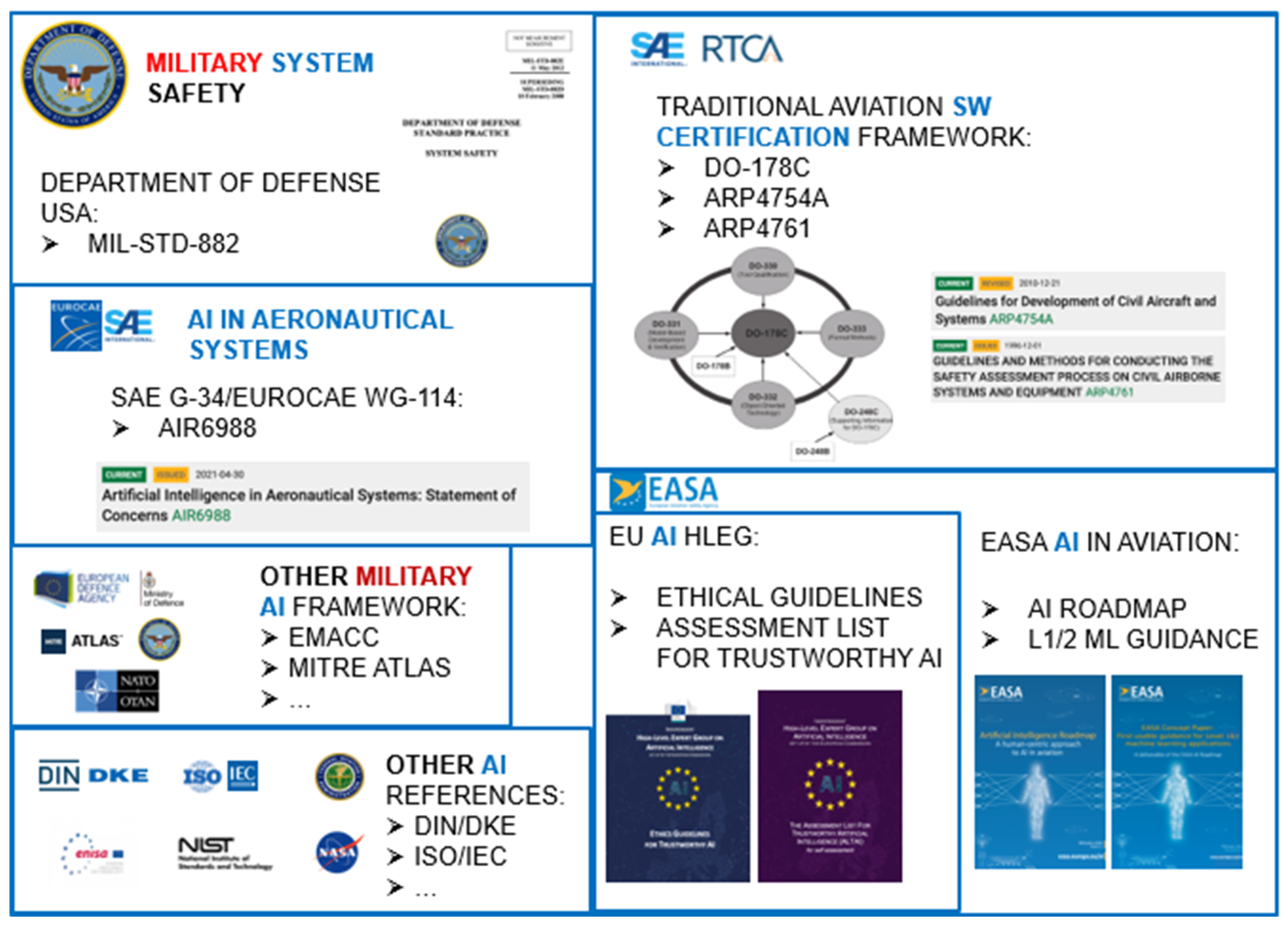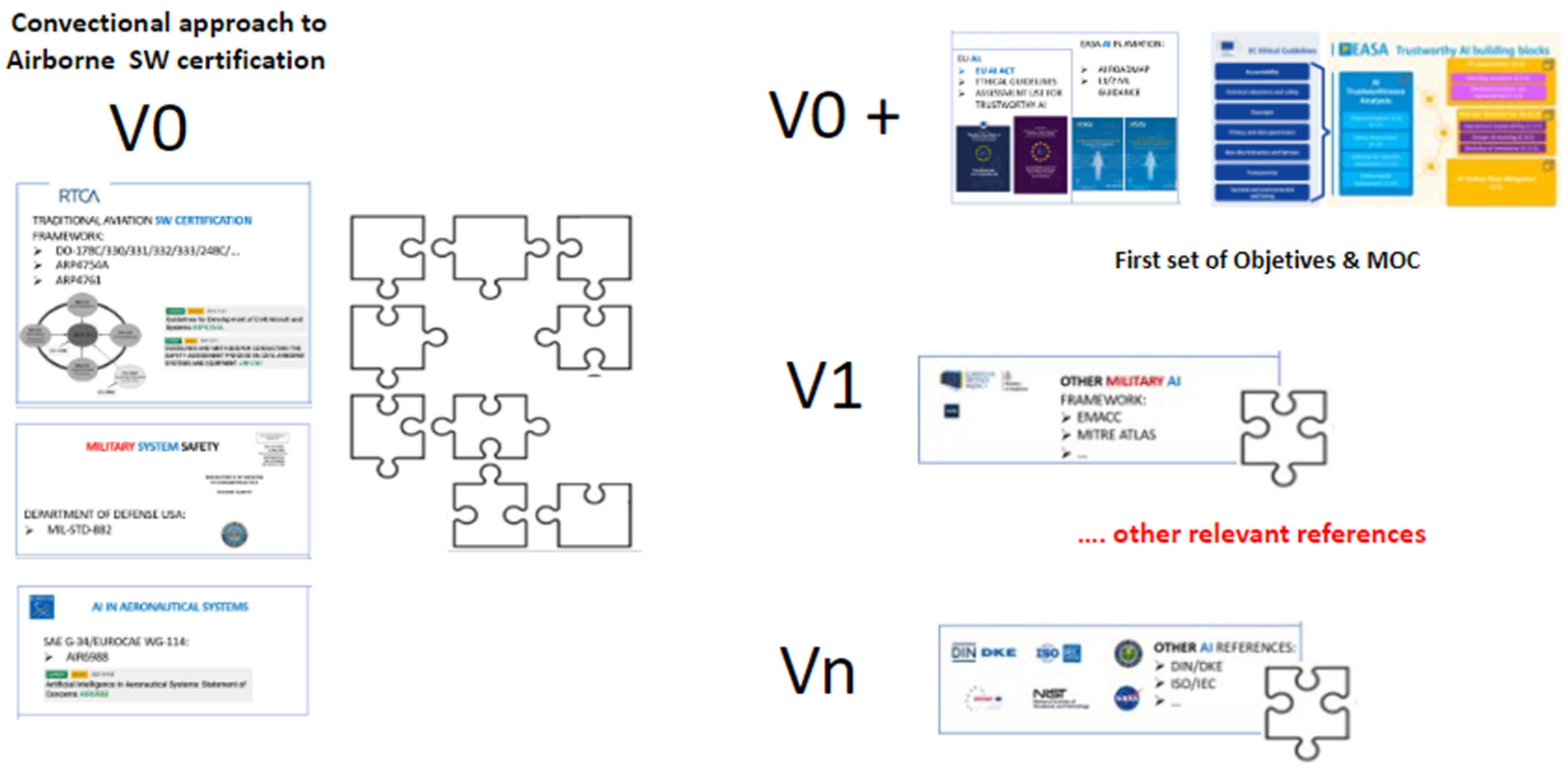Enhancing Safety in Military Aviation: A Systematic Approach to the Development of AI Certification Standards †
Abstract
1. Introduction
2. Standardization Domains Relevant to AI-Based Safety Critical Systems in Military Aviation
3. Motivation
4. Methodology
5. Model Developed: Template for the Analysis of the Certification Framework
- -
- Provide a concise summary of the key concepts within the standard.
- -
- Conduct a structured analysis across dimensions, comparing these concepts with the initial framework version.
- -
- Identify any gaps or needs revealed during the reference analysis.
- -
- Summary of Main Concepts: This section offers a brief overview of the central ideas presented in the reference, outlining key conclusions or concepts discussed.
- -
- Analysis by Dimensions Compared with the Initial Framework: This section analyzes how the reference addresses dimensions established in the initial certification framework for AI safety-critical systems. This comparison highlights overlaps or discrepancies and determines which dimensions the reference covers and from what perspective.
- -
- Identified Needs: This section identifies areas addressed by the reference that are not covered in the initial framework, aiming to identify potential needs for the new standard and harmonize concepts where common criteria are required.
6. Model Implementation: Example of the Assessment of References
6.1. Reference: ISO/IEC TR 24028:2020—Information Technology—Artificial Intelligence—Overview of Trustworthiness in Artificial Intelligence
6.1.1. Summary of the Main Concepts
- (a)
- Scope
- (b)
- Purpose
- (c)
- Description
6.1.2. Analysis by Dimensions Covered by the Reference in Comparison with the First Version of the New Standard
- -
- Regulatory Coverage: ISO/IEC TR 24028:2020 provides mitigation measures for vulnerabilities and threats in AI systems broadly, aligning fully with the initial version of the new standard. While the new standard offers a more detailed version, this document lays the theoretical groundwork for future developments. Model update considerations are mentioned but not included in the first version.
- -
- Technical Objectives: This document’s ideas are well integrated into the initial version’s technical objectives. However, considerations for model updates are absent. Approaches like incremental learning for modifying lean model behavior should be explored for defining continuing airworthiness requirements.
- -
- Technical Requirements: No references to technical requirements are made in the document.
- -
- Organizational Provisions: The document complies with organizational provisions in the first version of the new standard.
- -
- Anticipated Means of Compliance (aMoC): The general testing approaches presented, such as formal methods, empirical testing, intelligence comparison, testing in simulated environments, field trials, and comparison to human intelligence, could inform further definitions of aMoC for verification and validation. However, specific procedures are not detailed enough.
- -
- Acceptable Means of Compliance (AMC): No references to AMC are made in the document.
- -
- Guidance Material: The document could contribute to Guidance Material overviewing trustworthiness in AI systems, particularly in terms of mitigation measures, although more detailed adjustments would be necessary.
- -
- AI Trustworthiness Analysis: No additional applicable information is provided beyond what is covered in the first version of the framework.
- -
- AI Assurance: Additional considerations for assurance during model updates should be included in AI assurance for continuing airworthiness.
- -
- Human Factors for AI: Considerations about AI system misuse due to overreliance are not addressed in the first version of the new standard. Systems inspiring trust can lead to systemic failures in situations beyond their intended capabilities.
- -
- AI Safety Risk Mitigation: ISO/IEC TR 24028:2020’s mitigation measures could serve as Guidance Material for aMoC SRM-01, though system in-service experience-related measures are not explicitly covered in the first version of the framework. These include managing expectations, product labeling, and cognitive science relating to humans and automation.
- -
- Organizations and AI Management: No additional information is applicable to the first version of the framework.
- -
- Timeframe: Published in 2020, most concepts are already covered in the initial version of the framework.
- -
- Competence: Apart from mentioning training needs, no references to competencies are made.
- -
- Modulation of Objectives—LoR: No references to modulation of objectives are made.
- -
- Tool Qualification: No references to tool qualification are made.
- -
- Scaling AI: No references to scaling AI are made.
- -
- Embeddability: The document refers to IEC 61508 for methods and processes to implement fail-safe hardware in embedded ML, aligning with certifiable functional safety levels.
- -
- Frugality: No references to frugality are made.
- -
- Distributed AI: No references to distributed AI are made.
- -
- Adaptive AI: No references to adaptive AI are made.
6.1.3. List of Identified Needs
- -
- ISO/IEC 24028:2020 Updates for Continuing Airworthiness: This standard includes considerations on AI system updates for the continuing airworthiness certification process, advocating for methods like incremental learning. These aspects are not currently integrated into the first version of the new standard framework.
- -
- ISO/IEC 24028:2020 Testing Approaches: The document provides a brief overview of testing approaches applied to AI systems. The project should evaluate the suitability of each testing approach across different testing phases and properties (e.g., data completeness, inference model robustness, etc.).
- -
- ISO/IEC 24028:2020 Hardware (HW) Vulnerabilities: This standard highlights how HW vulnerabilities can significantly impact AI system performance and safety. The project should review and assess HW certification processes and standards to ensure their adequacy for AI methods.
- -
- ISO/IEC 24028:2020 In-Service Safety Measures: This standard addresses in-service safety measures for AI systems, such as expectations management, product labeling, and the impact of automation on human factors (e.g., overreliance). The project should ensure these measures are considered by the applicant.
7. Conclusions
Author Contributions
Funding
Institutional Review Board Statement
Informed Consent Statement
Data Availability Statement
Conflicts of Interest
References
- Dwivedi, Y.; Hughes, L.; Ismagilova, E.; Aarts, G.; Coombs, C.; Crick, T.; Williams, M.D. Artificial Intelligence (AI): Multidisciplinary perspectives on emerging challenges, opportunities, and agenda for research, practice and policy. Int. J. Inf. Manag. 2021, 57, 101994. [Google Scholar] [CrossRef]
- Duan, Y.; Edwards, J.S.; Dwivedi, Y.K. Artificial intelligence for decision making in the era of Big Data-evolution, challenges and research agenda. Int. J. Inf. Manag. 2019, 48, 63–71. [Google Scholar]
- Shneiderman, B. Brinding the gap between ethics and practice: Guidelines for reliable, safe, and trustworthy human-centered AI systems. ACM Trans. Interact. Intell. Syst. (TIIS) 2020, 10, 1–31. [Google Scholar]
- Khanna, S.; Srivastava, S. Patient-Centric Ethical Frameworks for Privacy, Transparency, and Bias Awarness in Deep Learning-Based Medical Systems. Appl. Res. Artif. Intell. Cloud Comput. 2020, 3, 16–35. [Google Scholar]
- Morgan, F.E.; Boudreaux, B.; Lohn, A.J.; Ashby, M.; Curriden, C.; Klima, K.; Grossman, D. Military Applications of Artificial Intelligence; RAND Corporation: Santa Monica, CA, USA, 2020. [Google Scholar]
- Shin, H.; Lee, J.; Kim, H.; Shim, D.H. An autonomous aerial combat framework for two-on-two engagements based on basic fighter maneuvers. Aerosp. Sci. Technol. 2018, 72, 305–315. [Google Scholar]
- Kong, W.; Zhou, D.; Du, Y.; Zhou, Y.; Zhao, Y. Reinforcement learning for multi-aircraft autunomous air combat in multi-sensor UCAV platform. IEEE Sens. J. 2022, 23, 20596–20606. [Google Scholar]
- Tutty, M.G.; White, T. Unlocking the future: Decision making in complex military and safety critical systems. In Proceedings of the Systems Engineering Test and Evaluation Conference, Sydney, Australia, 30 April–2 May 2018; Volume 30. [Google Scholar]
- Torens, C.; Durak, U.; Dauer, J.C. Guidelines and regulatory framework for machine learning in aviation. In Proceedings of the AIAA Scitech 2022 Forum, San Diego, CA, USA, 3–7 January 2022. [Google Scholar]
- Shu, Z.; Jia, Q.; Li, X.; Wang, W. An OODA loop-based function network modeling and simulation evaluation method for combat system-of-systems. In Proceedings of the Asian Simulation Conference, Beijing, China, 8–11 October 2016; Springer: Singapore, 2016; pp. 393–402. [Google Scholar]
- Layton, P. Fighting Artificial Intelligence Battles: Operational Concepts for Future AI-Enabled Wars. Network 2021, 4, 100. [Google Scholar]
- Guldal, M.R.; Andersson, J. Integrating Process Standards for System Safety Analysis to Enhance Efficiency in Initial Airworthiness Certification of Military Aircraft: A Systems Engineering Perspective. INCOSE Int. Symp. 2020, 30, 589–603. [Google Scholar] [CrossRef]
- Purton, L.; Kourousis, K. Military airworthiness management frameworks: A critical review. Procedia Eng. 2014, 80, 545–564. [Google Scholar] [CrossRef]
- Missoni, E.; Nikolić, N.; Missoni, I. Civil aviation rules on crew flight time, flight duty, and rest: Comparison of 10 ICAO member states. Aviat. Space Environ. Med. 2009, 80, 135–138. [Google Scholar]
- Cihon, P. Standards for AI Governance: International Standards to Enable Global Coordination in AI Research & Development; Future of Humanity Institute, University of Oxford: Oxford, UK, 2019. [Google Scholar]
- Danks, D.; London, A.J. Regulating autonomous systems: Beyond standards. IEEE Intell. Syst. 2017, 32, 88–91. [Google Scholar]
- Wang, Y.; Chung, S.H. Artificial intelligence in safety-critical systems: A systematic review. Ind. Manag. Data Syst. 2022, 122, 442–470. [Google Scholar]
- Kläs, M.; Adler, R.; Jöckel, L.; Groß, J.; Reich, J. Using Complementary Risk Acceptance Criteria to Structure Assurance Cases for Safety-Critical AI Components. In AISafety@ IJCAI; Fraunhofer IESE: Kaiserslautern, Germany, 2021; Available online: https://ceur-ws.org/Vol-2916/paper_9.pdf (accessed on 1 March 2025).
- Piao, H.; Han, Y.; Chen, H.; Peng, X.; Fan, S.; Sun, Y.; Zhou, D. Complex relationship graph abstraction for autonomous air combat collaboration: A learning and expert knowledge hybrid approach. Expert Syst. Appl. 2023, 215, 119285. [Google Scholar]
- RTCA DO-178C; Software Considerations in Airborne Systems and Equipment Certification. 5 January 2012. 1150 18th NW, Suite 910 Washington, D.C. 20036. Available online: https://www.rtca.org/do-178/ (accessed on 1 March 2025).
- MIL-HDBK-516C; Department of Defense Handbook: Airworthiness Certification Criteria. 12 December 2014. Department of Defense, United States of America. Available online: http://everyspec.com/MIL-HDBK/MIL-HDBK-0500-0599/MIL-HDBK-516C_52120/ (accessed on 1 March 2025).
- SAE International. Guidelines and Methods for Conducting the Safety Assessment Process on Civil Airborne Systems and Equipment ARP4761; SAE International: Warrendale, PA, USA, 1996. [Google Scholar]
- SAE International. Guidelines for Development of Civil Aircraft and Systems ARP4754A; SAE International: Warrendale, PA, USA, 2010. [Google Scholar]
- EASA. Certification Specifications for Large Aeroplanes (CS-25); EASA: Cologne, Germany, 2007. [Google Scholar]
- EASA. Easy Access Rules for Acceptable Means of Compliance for Airworthiness of Products, Parts and Appliances (AMC-20); EASA: Cologne, Germany, 2023. [Google Scholar]
- EASA. Artificial Intelligence Roadmap 2.0. Human-Centric Approach to AI in Aviation; EASA: Cologne, Germany, 2023. [Google Scholar]
- EASA. EASA Concept Paper: First Usable Guidance for Level 1&2 Machine Learning Applications; EASA: Cologne, Germany, 2023. [Google Scholar]
- The Open Group. The TOGAF® Standard, Version 9.2. San Francisco, EEUU. 16 April 2018. Available online: https://publications.opengroup.org/ (accessed on 1 March 2025).


Disclaimer/Publisher’s Note: The statements, opinions and data contained in all publications are solely those of the individual author(s) and contributor(s) and not of MDPI and/or the editor(s). MDPI and/or the editor(s) disclaim responsibility for any injury to people or property resulting from any ideas, methods, instructions or products referred to in the content. |
© 2025 by the authors. Licensee MDPI, Basel, Switzerland. This article is an open access article distributed under the terms and conditions of the Creative Commons Attribution (CC BY) license (https://creativecommons.org/licenses/by/4.0/).
Share and Cite
Jurado, R.D.-A.; Plaza, V.O.; Ye, X.; Suárez, M.Z.; Moreno, F.P.; Arnaldo, C.G. Enhancing Safety in Military Aviation: A Systematic Approach to the Development of AI Certification Standards. Eng. Proc. 2025, 90, 83. https://doi.org/10.3390/engproc2025090083
Jurado RD-A, Plaza VO, Ye X, Suárez MZ, Moreno FP, Arnaldo CG. Enhancing Safety in Military Aviation: A Systematic Approach to the Development of AI Certification Standards. Engineering Proceedings. 2025; 90(1):83. https://doi.org/10.3390/engproc2025090083
Chicago/Turabian StyleJurado, Raquel Delgado-Aguilera, Vicent Ortolá Plaza, Xiaojie Ye, María Zamarreño Suárez, Francisco Pérez Moreno, and César Gómez Arnaldo. 2025. "Enhancing Safety in Military Aviation: A Systematic Approach to the Development of AI Certification Standards" Engineering Proceedings 90, no. 1: 83. https://doi.org/10.3390/engproc2025090083
APA StyleJurado, R. D.-A., Plaza, V. O., Ye, X., Suárez, M. Z., Moreno, F. P., & Arnaldo, C. G. (2025). Enhancing Safety in Military Aviation: A Systematic Approach to the Development of AI Certification Standards. Engineering Proceedings, 90(1), 83. https://doi.org/10.3390/engproc2025090083






